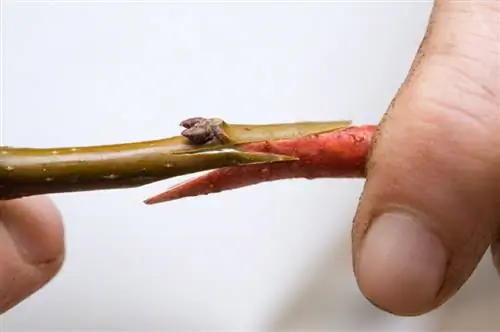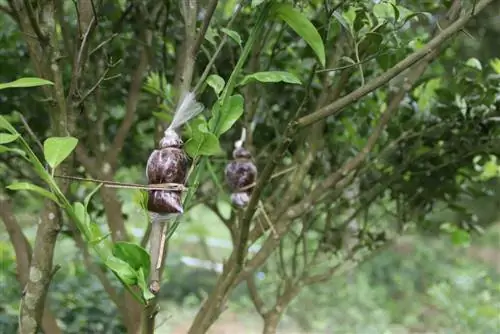- Author admin [email protected].
- Public 2024-01-05 20:48.
- Last modified 2025-01-23 11:20.
Autumn is the best time to plant roses. Many of these prickly plants were grafted - that is, a particularly beautifully flowering but sensitive specimen was placed on top of a particularly resistant or strong-growing one - so that many inexperienced gardeners now ask themselves: Where should the grafting point go?

Where should the grafting point for roses be planted?
For grafted roses, the grafting site should be buried 5-10 cm deep into the ground to protect against frost damage, injury and breakage, as well as to provide winter protection and better growth. Exception: rose stems.
Refining center belongs underground
For grafted roses, the grafting point should always be buried at least five, preferably seven to ten, centimeters deep into the ground. There are various reasons for this:
1. Finishing areas are particularly sensitive to frost damage and injuries.
2. Roses “break off” quickly at this point, so burying them can provide some protection.
3. Grafted roses are usually very sensitive to frost and cold winter air, which is why burying the grafting site provides basic winter protection - which can also be improved by piling up with soil.4. Grafted roses often only show weak growth. With a bit of luck, roots will sprout from the grafting site over time, so that at some point the rose will literally stand on its own two feet.
Exception: rose stems and wild roses
Only with rose stems should you not bury the grafting point in the ground. In this case you would have to sink the entire trunk, because the thickening is located directly below the crown. However, you can overwinter stem roses that are still young and sufficiently flexible by pressing down the crown and burying it along with the grafting area.
How do you recognize the processing center?
For roses (with the exception of standard roses), the grafting point is always just above the roots. This is a thickening above which all shoots sprout - ideally at least. Shoots that grow below this nub are usually wild shoots (i.e. they come from the rootstock) and are therefore not desirable.
Protect processing center
The finishing point should not only be protected by burying it, but also in other ways. This protection is particularly important in winter, which is why roses should always be piled up. This warming earth covering is ideally covered with fir branches, which serves both protection and aesthetics. After all, who likes to look at bare piles of earth for months?
Tip
If you are unsure about differentiating between noble and wild shoots, the following rule of thumb will help you: Noble roses always have five leaves on a shoot, while most wild roses used as rootstock have six to seven.






